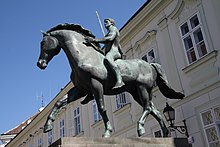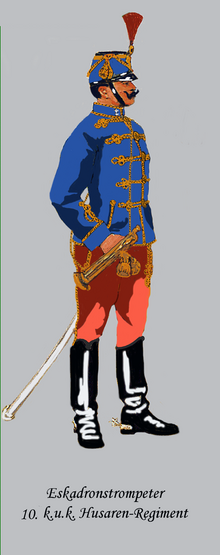kuk hussar regiment "Friedrich Wilhelm III. King of Prussia ”No. 10
The hussar regiment “Friedrich Wilhelm III. King of Prussia ”No. 10 was set up in 1741 as the Austro-Habsburg cavalry association. The unit then existed in the Austro-Hungarian or Joint Army within the Austro-Hungarian Land Forces until it was dissolved in 1918.
When a cavalry ranking was drawn up in 1769, the association was given the name Cavalry Regiment No. 35 .
In 1888 it was ordered that the regiment should be named “Friedrich Wilhelm III. King of Prussia ”for all time .
All honorary names of the regiments were deleted without replacement in 1915. From then on the regiment was only to be called "Hussar Regiment No. 10". (However, this could not be implemented in practice, on the one hand because no one adhered to it, on the other hand because the very thrifty Austro-Hungarian military administration had ordered that all forms and stamps that were still available first be used!)
Status and association membership 1914
- IV Corps - 10th Cavalry Troop Division - 4th Cavalry Brigade
- Nationalities: 97% Magyars - 3% others
- Uniform: light blue Attila with yellow olives and light blue shako cover
- Garrison : Budapest (Franz Josef Cavalry Barracks - Xth District, Kerepesi-út 41) Replacement cadre in Szekesvehervar
- Commanding officer: Lieutenant Colonel Koloman Markovits
- Regimental language: Hungarian
Establishment
- On December 8, 1741, Emperor Franz I granted Colonel Beleznay a patent to set up a hussar regiment. Eight companies could initially be established.
- In 1748 a company of the disbanded Hussar Regiment Trips could be incorporated
- In 1768 another company from the disbanded Hadik Hussar Regiment was assigned
- In 1769 the regiment received the cavalry master list number 35
- In 1775 a division of the disbanded Hussar Regiment Török was assigned
- 1798 had a division of the merged Hussars. 7 be submitted
- In 1849 because of the participation in the revolt in Hungary, the regiment was moved to Klattau in Bohemia and reorganized there
- In 1860, a squadron was formed from the 4th Division to be disbanded and transferred to the Voluntary Hussar Regiment No. 2
Supplementary districts
- 1781 Kosice
- 1809 Kosice and Presov
- 1853–60 Kaschau, Mukacevo , Erlau
- 1860–67 Ofen , Szolnok , Erlau
- 1867–73 Raab , Stuhlweissenburg
- 1883–89 Kaposvár , Fünfkirchen , Stuhlweissenburg
- 1889 from the area of IV Corps - Budapest
Peace garrisons
| I. | II. | III. |
|---|---|---|
|
Regimental owner
- 1741 Colonel Johann von Beleznay (Beleznay Hussar Regiment)
- 1754 Field Marshal Lieutenant Emerich Freiherr von Morocz (Hussar Regiment Morocz)
- 1759 Major General Joseph Adam Graf Bethlen (Hussar Regiment Graf Bethlen)
- 1772 unoccupied (Hussar Regiment Dées)
- 1773 Field Marshal Lieutenant Vincenz Freiherr von Barcó (Hussar Regiment Barcò)
- 1797 Lieutenant Field Marshal Johann Freiherr von Mészáros (Hussar Regiment Mészarós)
- 1798 Change of name to Hussar Regiment No. 10
- 1802 Field Marshal Lieutenant Joseph Freiherr Stipsicz von Ternova
- 1814–40 Friedrich Wilhelm III. , King of Prussia
- 1840 Friedrich Wilhelm IV. , King of Prussia
- 1861 Lieutenant Field Marshal Carl Freiherr von Lederer
- 1868–73 vacant
- 1873 Wilhelm I , German Emperor and King of Prussia
- 1888 Friedrich III. German Emperor and King of Prussia
- 1888 Owner position was no longer filled
Battle calendar
War of the Austrian Succession
- 1741 Immediately after the deployment to Silesia, a detachment took part in the battle near Olberndorf
- 1742 Fighting in front of Brno, the regiment broke through the siege ring and was able to get into the city. Winter campaign in Moravia and participation in the siege of Prague
- 1743 patrol and security services in Germany
- 1744 Patrol and reconnaissance services in the Spanish Netherlands , a division in action near Bruges
- 1745 Assigned to the army of Field Marshal Otto Ferdinand von Abensperg and Traun on the Lower Rhine. Battle at Nordheim
- 1746 Battle of Rocour
- 1747 Participation in the battle of Lauffeldt
- 1748 parts of the regiment are defending Maastricht
- 1756 Patrol and reconnaissance services in Bohemia
- 1757 Patrol and reconnaissance services in front of Prague , later in Silesia , raid against Zittau
- 1758 patrol and reconnaissance services in Moravia , later deployed in the siege of Neisse .
- 1759 Assigned to the Beck Corps. Battle at Grünberg
- 1760 Assigned to Loudon Corps. Skirmishes near Cosdorf, fighting near Landshut and Liegnitz
- 1761 Battle of Opole
- 1762 Battle near Peilau (on the Fischerberge)
War of the Bavarian Succession
- 1778 Skirmish Trautenau in Bohemia, a division leads a battle near Dittersbach
- 1779 Parts of the regiment are involved in the storming of Habelschwerdt, two divisions are involved in the attack on Ober-Schwedeldorf
Russo-Austrian Turkish War (1787–1792)
- 1788 Assigned to the army of Prince Coburg , the regiment stood at Chotin . Smaller skirmishes at Poljano, Rukszin and Chotin
- 1789 A division fights at Vale-Saka, the whole regiment fights with distinction at Focșani and Martinestie Turnul
- 1793 fighting in the Spanish Netherlands and northern France. Battles at Valenciennes- Saultain, Neuville, Villers-en-Cauchies and Bouvignies. Battle of Famars , where divisions of the regiment excelled in storming the entrenchments and capturing enemy artillery
- 1794 parts of the regiment fought at Landrecies , Rouvroy , Lüttich , Aachen and Henri-Capelle
- 1795 Detachments lead smaller skirmishes near Mainz , Meisenheim and Morbach
- 1796 fighting at Ukerath, Amberg and Würzburg . Skirmishes of individual detachments near Aschaffenburg and Bingen
- 1797 Heavy losses in the battle near Hochheim am Main
- 1799 Battles in Germany and Switzerland near Ostrach-Stockach, Andelfingen and Brunnen.
- 1800 Battle of Engen , then in battles near Messkirch , Biberach , Schwabmünchen , Hohenlinden and Asten.
- 1805 fighting at Caldiero in Italy
- 1809 Seven squadrons assigned to the Rosenberg corps fought at Landshut Dinzling and Eggmühl . The 8th Squadron was in Passau to reinforce the crew . Battle of the regiment near Aderklau, participation in the battle near Aspern and in the battles near Stadtl-Enzersdorf, Esslingen and the battle near Wagram . Retreat battles at Mistelbach
- 1813 fighting in Inner Austria near Krainburg, then on the advance near Villanova, Monzambano and Caldiero
- 1814 Four squadrons in the Sommariva division near Monzambano and involved in the blockades of Mantua , Legnago and Venice .
- In 1815 Macon was captured in the south of France, then with the occupying army in Alsace .
Revolution of 1848/1849 in the Austrian Empire
- 1848 Two divisions followed the call of the Hungarian secessionist government and marched from Galicia to Hungary, where they took part in the revolt and fought against the imperial troops and their allies. The other two divisions could be kept with the flag, but suffered badly from desertion .
- In 1859 , units assigned to the Schwarzenberg Corps fought at la Cava, Torre di Beretti and Valenza. In the Battle of Magenta it covered the retreat of the corps and later fought in the Battle of Solferino
- 1866 Five squadrons were in the Northern Army, individual detachments fought at Rochlitz , Sichrov, Gitschin , the battle of Königgrätz and Mährisch-Budwitz
During the First World War, the hussars were exposed to a wide variety of uses. At first they fought as cavalry in the regimental unit, but were also used as infantry in all theaters of war. It is currently unknown whether the regiment was deployed as a unit or as a split division cavalry . The status as a cavalry regiment existed until the end of the war.
After the end of the war, the regiment returned from Bulgaria in an orderly manner and was demobilized in Budapest.
structure
In the Austro-Hungarian Cavalry, a regiment usually consisted of three to four (in exceptional cases more) divisions . (A division was used here to refer to a battalion-strength unit. The correct division was called an infantry or cavalry division.) Each division had three squadrons , each of which consisted of two companies . The number of riders in the individual sub-units fluctuated, but was usually around 80 riders per company.
The individual divisions were named after their formal leaders:
- the 1st division was the colonel division
- the 2nd division was the lieutenant colonel (lieutenant colonel) division
- the 3rd division was the majors division
- the 4th division was the 2nd majors division
- the 5th division (if any) was the 3rd majors division
In the course of the army reform, the cavalry regiments were reduced to two divisions from 1860 onwards.
Until 1798, the regiments were named after their respective owners (who did not also have to be the commanders). There was no binding regulation of the spelling. (e.g. Count Serbelloni regiment - or Serbelloni regiment.) With each change of ownership, the regiment concerned changed its name. After 1798, the numbered designation prevailed, which could possibly be linked to the name of the owner. Due to this constant renaming, the regimental histories of the Austro-Hungarian cavalry are very difficult to follow. In addition, there is the constant and apparently arbitrary, sometimes multiple reclassification of the associations. (For example: Kuk Bohemian Dragoon Regiment "Prince of Windisch-Graetz" No. 14 )
- see: kuk hussars
literature
- Obstlt. Alphons Frhr. v. Wrede: History of the KuK Wehrmacht from 1618 to the end of the XIX century Vienna 1898–1905.
- Georg Schreiber : The emperor's cavalry. Austrian cavalry in 4 centuries. With a foreword by Alois Podhajsky . Speidel, Vienna 1967.
- BM Buchmann: Austria and the Ottoman Empire. WUV-Univ.-Verl., Vienna 1999.
- Allmayer-Beck / Lessing: The K. (below) K. Army 1848–1914. Bertelsmann, Munich 1974.
Individual evidence
- ↑ according to “Announcement of the Quartermaster's Department” of Army Group Command FM. Archduke Eugen / Q.Op. No. 665/15. Issued by the field post office 512






